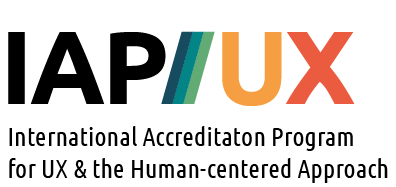The International Accreditation Program for UX Professionals is new initative, reaching out to people in the field of work in human-centered design, UX, Usability and related areas. As there is a wide variety of educational backgrounds, work histories, life experiences… we want to make this program as transparent and responsible as possible.
Yes, if you do have a degree from any kind of school that fits one of the areas outlined in the accreditation process, you are asked to show at least 5 years of work experience. Without a degree in a specific occupational field, you are asked to show at least 8 years of experience.
Yes, if you have a certificate from a multi-day training program for UX, which has been issued by a reconized provider, you can use that certificate as one of the three required recommendations. These training programs must exhibit a transparent curriculum to be acceptable to the accreditation program, like UXQCC, UXQB, Fraunhofer FIT etc. The list of these programs will be regularily reviewed and extended, we kindly ask for your patience.
No, you may only use one certification as a recommendation. We still feel the need to learn about you and your work by the words of those that worked with you.
As of today, the program is available in English and German. We are working to add more languages as soon as posible. But do not despair: just translate the most important parts of your artifacts and deliverables that you want to share to English. The additional explanation (as outlined in the respective step for accreditation) has to be in English anyway. The same is valid for recommendations.
The accreditation program is applying a peer review approach. That means, that depending on the focus areas you chose, accrediting members of the accreditation program will review your submitted information. Those accrediting members of the program are accredited in the relevant focus areas.
If you are not allowed to use a project or parts of a project as reference because an NDA is in place, we kindly ask you to eleminate all specific names / specifications or otherwise potential relevant information from all artifacts you might want to use. Rephrase texts, remove all detailed specifics that might violate an NDA and so forth. We also look forward to generic work artifacts that focus on methods / work instead of results or solutions. In such cases, the review of the additional information about the context of use and your work is very important.
Once you have successfully completed the accreditation, you may keep the accreditation for a lifetime. However, if you decide to pursue a career outside of UX/Human-centered Design, you can authorize the accrediting body to withdraw your accreditation (so that you are no longer listed on the registry of UX Professionals). A possibility to forfeit ones accreditation is, when you choose to do your work in an unprofessional / unethical way, thus violating the Code of Conduct.
The accreditation as UX Professional lasts a lifetime. That being said, you might lose that accreditation, if you choose not to work according to the Code of Conduct. We are not a police that assesses every action and decision you make. But repetetive, deliberate violations of our Code of Conduct might lead to removal of your accreditation. A person that does not act as an professional is not a professional. A respective process that specifies escalations related to the Code of Conduct is being defined and will be published on this system.
The Code of Conduct is assisting our work, and is also intended to protect you from unwanted and inappropriate influence from others that want you to do things that are unprofessional and unethical. Your professionalism, your work ethics, your accreditaion is at stake when you do things that might harm humans, exposes users to risks, to dark patterns, to increased unnecessary stress etc.
We know that nobody is perfect. But we as UX Professionals dedicate our work to make the world a better place.
Unfortunately not. As of today, the accreditation requires 5 or 8 years of work experience as an UX Professional in at least one of the focus areas. We kindly ask you to wait and to gather work references up to that point in order to be able to show us your approach to the work in UX/Human-centered Design. If you want the accreditation program to work on a “young professionals” accreditation, please tell us (we are aware of the situation of young professionals and are actively discussing how to address issues related to that).
No, we don’t require or even expect a specifc tool that you have to use to show us your work references. In fact, we kindly ask to send PDFs of your artifacts or deliverables, of links to references instead.
No, there is no formula that tells us that a work reference of e.g. an user interface is x times more important than a research study. All work references are treated equal.
The accreditation cost is 350 Euro / US Dollar. Please note, that the payment doesn’t ensure that you pass the accreditation, which is based purely on your professional information that you submit. You cannot “buy” an accreditation.
We are working on a model to provide UXPA Chapter members a discount / reduced accreditation fee. As soon as this offer is available, we will update the information on this website.
Focus areas each describe thematically related activities of UX Professionals. These activities can often describe a specific role, whereby a UX professional can occupy several roles, i.e. several focus areas. These different areas are usually characterized by specific qualification, their own methods and procedures, as well as by dedicated artifacts and deliverables.
We ask applicants to choose up to 3 focus areas that match ones expertise and for which they would like to accredidate.
You’ll find the focus areas here: https://ux-accreditation.org/focus-areas/
We are convinced that professional and high-quality work in the various focus areas cannot be done by one person over many years. The necessary training, the methods and tools used, and the experience gained are too different. Nevertheless, we acknowledge that some UX professionals might be able to work in all different focus areas – but not in all of them in the same, high quality. We invite you to focus on your most important areas of work, to proof your expertise in those focus areas and to acknowledge, that some areas might not be so much your home base…
Nevertheless, we are also working on a follow up accreditation, where accredited UX Professionals can add a fourth focus area to their accreditation. As soon as this extension of the program is available, we will add this information on this website.
Based on human-centered design, a customer is a specific user. i.e. a user that “buys” a product, system or service. Therefore, not every user is a customer, but every customer is a user.
As long as a CX Professional is engaged in planning, desing, implement, deploying or testing products, systems or services, and acknowledge the principles of human-centered design, CX Professionals are also UX Professionals.
If information is missing, incorrect, or incomplete on your application, you will be notified by the accrediting body and informed of the data that needs to be provided.
You will then have a one-time opportunity to submit this information. If the supplemented information is still insufficient or incorrect, the accreditation application is considered unsuccessful. In this case, the reasons for this decision will be communicated to the applicant.
If you want to try again to accreditate as UX Professional, you will have to reapply.
This is a new program and we are learning to process the requestst. We also want to apply due dilligence in the review of submitted material. As we all are working in our regular jobs, the program is an additional effort that requires both time and dedication, we focus of a timely response if possible. An application for accreditation should be processed within 6 to 12 weeks.
As soon as you have received your UX Accreditation number, you can do the following things (as examples):
- Add your number to your email signature. Under your name, add a new line with the text
“Accredited UX Professional” and then your number in the format of “#xxxxxxxxx”
Example
Firstname Lastname
Accredited UX Professional #010203999 - In LinkedIn, you can add your unique number in your profiles headline with the text
“Accredited UX Professional” and then your number in the format of “#xxxxxxxxx”. - In LinkedIn, you can add a section called “Licences & Certifications” to your profile (in case you haven’t done so before). Then add an entry using the Name “Accredited UX Professional” with the Issuing organization “International Accreditation Program for UX Professionals” (this is our organization that sports a logo), the respective Issue date of your accreditation, the Credential ID (which is your accreditation number) and the Credential URL “www.ux-accreditation.org”.
After successful accreditation procedure, you get your own, unique and personal accreditation number, which will identify you in the register of accredited UX professionals. This number is issued only once and will stay with you as long as you are in the register. You can think of it like a professional “fingerprint”.

